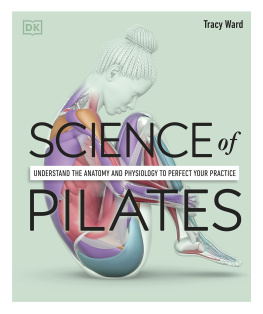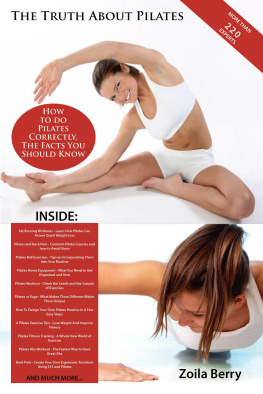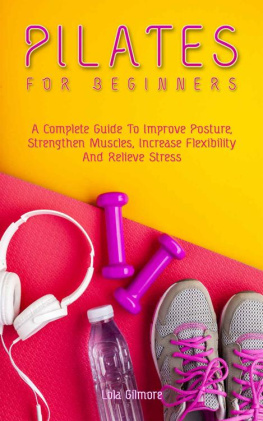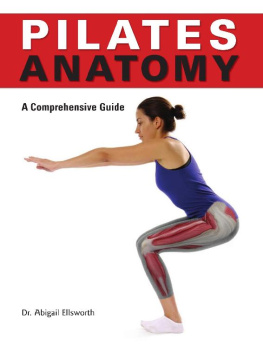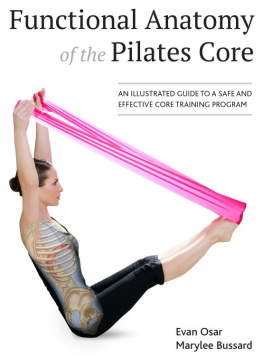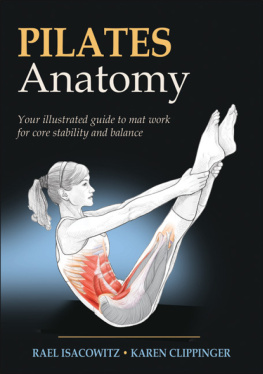Contents
Guide
Pagebreaks of the print version
SECOND EDITION
Pilates
ANATOMY
Rael Isacowitz
Karen Clippinger
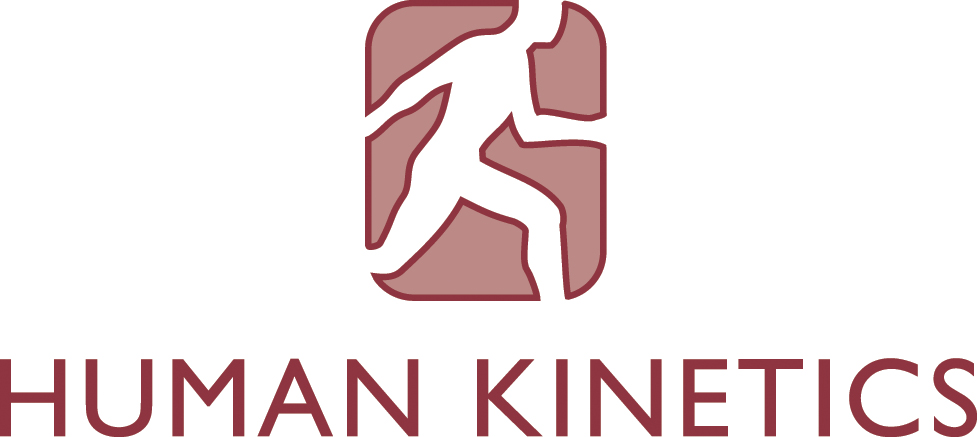
Library of Congress Cataloging-in-Publication Data
Names: Isacowitz, Rael, 1955- author. | Clippinger, Karen S., author.
Title: Pilates anatomy / Rael Isacowitz, Karen Clippinger.
Description: Second edition. | Champaign, IL : Human Kinetics, [2020] | Includes bibliographical references.
Identifiers: LCCN 2019005198 (print) | LCCN 2019005668 (ebook) | ISBN 9781492592532 (epub) | ISBN 9781492567714 (PDF) | ISBN 9781492567707 (print)
Subjects: LCSH: Pilates method.
Classification: LCC RA781.4 (ebook) | LCC RA781.4 .I74 2020 (print) | DDC 613.7/192--dc23
LC record available at https://lccn.loc.gov/2019005198
ISBN: 978-1-4925-6770-7 (print)
Copyright 2020, 2011 by Rael Isacowitz and Karen Clippinger
Human Kinetics supports copyright. Copyright fuels scientific and artistic endeavor, encourages authors to create new works, and promotes free speech. Thank you for buying an authorized edition of this work and for complying with copyright laws by not reproducing, scanning, or distributing any part of it in any form without written permission from the publisher. You are supporting authors and allowing Human Kinetics to continue to publish works that increase the knowledge, enhance the performance, and improve the lives of people all over the world.
This publication is written and published to provide accurate and authoritative information relevant to the subject matter presented. It is published and sold with the understanding that the author and publisher are not engaged in rendering legal, medical, or other professional services by reason of their authorship or publication of this work. If medical or other expert assistance is required, the services of a competent professional person should be sought.
The web addresses cited in this text were current as of November 2018, unless otherwise noted.
Senior Acquisitions Editor: Michelle Maloney; Senior Developmental Editor: Cynthia McEntire; Senior Managing Editor: Amy Stahl; Copyeditor: Annette Pierce; Graphic Designer: Whitney Milburn; Cover Designer: Keri Evans; Cover Design Associate: Susan Rothermel Allen; Photographs (for illustration references): Kirk Fitzek; Cover Model (for illustration reference): Yuki Yoshii; Interior Models (for illustration reference): Antonella Redekosky, Devon Reuvekamp, Ena Kirima, Lisa Clayton Hubbard, Stephanie Powell, Yuki Yoshii; Photo Production Manager: Jason Allen; Senior Art Manager: Kelly Hendren; Illustrations: Heidi Richter and Molly Borman/ Human Kinetics; Printer: Versa Press
We thank BASI Pilates Academy and Studio in Newport Beach, California, for assistance in providing the location for the photo shoot for this book.
Human Kinetics books are available at special discounts for bulk purchase. Special editions or book excerpts can also be created to specification. For details, contact the Special Sales Manager at Human Kinetics.
Printed in the United States of America 10 9 8 7 6 5 4 3 2 1
The paper in this book is certified under a sustainable forestry program.
Human Kinetics
P.O. Box 5076
Champaign, IL 61825-5076
Website: www.HumanKinetics.com
In the United States, email info@hkusa.com or call 800-747-4457.
In Canada, email info@hkcanada.com.
In the United Kingdom/Europe, email hk@hkeurope.com.
For information about Human Kinetics coverage in other areas of the world, please visit our website: www.HumanKinetics.com
E7324

To Joseph and Clara Pilates and the many dedicated teachers who have kept their vision alive
CONTENTS
PREFACE
As the authors of Pilates Anatomy, we were extremely encouraged by the response to the first edition. It reached across the globe after its release in 2011, being translated into multiple languages. Now as we embark on the second edition, we hope for an equally positive response. For this edition, we added valuable information, focusing on the inclusion of expanded modifications and progressions. Modifications make the exercises more accessible and should be used as stepping stones to performing the original version of the exercise safely. Progressions add appropriate difficulty and challenge to the exercise. Progressions also can be valuable stepping stones, in many cases helping to develop specific skills necessary for doing a more advanced, but related, Pilates exercise.
In the past two decades, a profound evolution of Pilates has occurred. The Pilates industry seemed to reach a tipping point (a point of critical mass) in the mid- to late 1990s, whereby it morphed from a little-known form of exercise with a devout but small following that included dancers, singers, circus performers, and actors to a mainstream fitness regimen practiced in many households. It suddenly started appearing in Hollywood movies and television commercials, in cartoons and comedy shows, and on late-night television. It became synonymous with going to Starbucks and indulging in a low-fat triple-shot soy latte (no whipped cream please!).
How this happened, why this happened, and to what this phenomenon can be attributed remain somewhat of an enigma. However, few can dispute that the growth of active participants in the United States from approximately 1.7 million in 2000 to approximately 10.6 million in 2006 is a phenomenon. Worldwide participation has also grown exponentially, and continues to grow, while the United States has seen a small decline to around 9.05 million in 2017. Of course, all growth comes with growing pains, and the Pilates industry is no exception. The accelerated education, which is often a part of rapid growth, has certainly taken hold in Pilates. Although we favor a more comprehensive approach, the accelerated approach has been one part of the expansion of Pilates that has led to a multitude of positive outcomes, such as Pilates filtering into many new arenas including fitness clubs, training programs for athletes, and medical facilities.
Understanding Pilates requires some knowledge of its history. Joseph Pilates was born on December 9, 1883, near Dsseldorf, Germany. He died on October 9, 1967. Unfortunately he didnt live to see the realization of his dreams. He adamantly believed that his approach to total well-being should be embraced by the masses and certainly by health care professionals. He hoped that contrology, as he called his system, would be taught in schools throughout the United States. He intended his method to be a mainstream form of conditioning for men, and initially it was practiced more by men, although it is largely women who have kept the flame alive all these years.
It is fortunate that several early students of Mr. Pilates and his wife, Clara, whom he met on his second trip to the United States in 1926 and who became his lifelong partner in his work, survived them and became exceptional teachers in their own right. These first-generation Pilates teachers, taught directly by Joseph and Clara Pilates, have played a profound role in the evolution of the Pilates industry. Rael Isacowitz has had the distinct privilege of studying with several members of this unique group over the past 40 years. Ms. Kathleen Stanford Grant must be singled out as having a particularly powerful effect on this authors development and teaching style.


